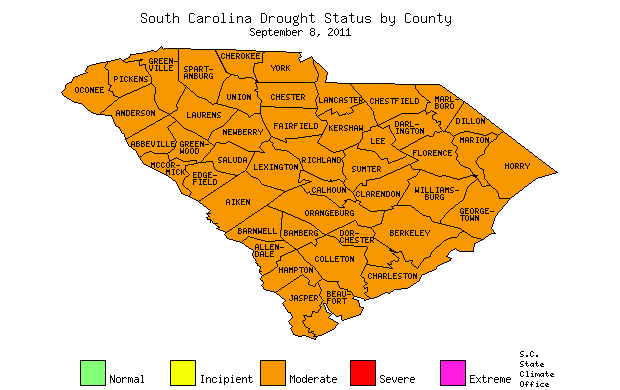

For previously issued drought statements see the archived status reports.
Table of all counties and drought status.Members of the S.C. Drought Response Committee, meeting via tele-conference on Sept. 8, designated all counties in the state to moderate drought status. Horry and Marion counties were lowered from severe to moderate drought status. The committee's decision to maintain or upgrade was driven by continuing concern over agricultural impacts, low stream flows and the potential for increased forest fire activity. Recent rainfall from tropical storms brought some temporary relief to parts of the Pee Dee area, but conditions continue to deteriorate elsewhere in South Carolina. The moderate drought declaration is followed by increasing levels of severity to severe and extreme status.
David Tompkins with the S.C. Department of Agriculture reported, "Pastures, grazing lands and hay production have been an ongoing issue for many livestock owners. We're also concerned with the drought impact on cotton and soy crops."
Darryl Jones with the S.C. Forestry Commission reported, "We had an extremely busy summer and our concern is for the potential of another active wildfire season going into fall. Hurricane Irene and other productive storms have delivered improvement of drought conditions in Horry and Marion counties, which has allowed us to control wildfires in those areas. We're still concerned about conditions around the state over the next several weeks."Scott Harder, S.C. Department of Natural Resources (DNR) hydrologist, reported most of the major lakes around the state are below their target level for this time year. He noted Keowee, Jocassee, Hartwell and Thurmond lakes are currently the hardest hit by drought. All streamflow gauges in the Upper Savannah River Basin are approaching critical low flows for this time of year. He also spoke about the steady decline in the Oconee County USGS monitoring well.
Jason Ward, a hydrologist with the U.S. Army Corps of Engineers, advised the committee that the Savannah River Basin was upgraded to the second stage of drought on Aug. 31, 2011, "Basin inflows are approximately 5% - 30% of normal for the 30 day average." The U.S. Army Corps of Engineers drought level two requires a maximum weekly average water release of 4,000 CFS (cubic feet per second) downstream from Lake Thurmond.
The moderate declaration does not require any mandatory action by public water systems or the public, but all water systems should take the opportunity to review their local drought plans and ordinances and where needed implement accordingly. Hope Mizzell, SC State Climatologist said, "The committee has to make decisions based on the overall drought impacts on agriculture, water supply, and forestry in each county." She stressed that conditions in some isolated areas are already beyond moderate drought and that some water systems may need to implement more stringent water conservation measures. Mizzell also stated that, "We are entering the driest months climatologically, October-November, and without rainfall from tropical systems, rainfall amounts during these months can be very low."
Mike Caston with SJWD Water District in Spartanburg County reported, "The drought has worsened in our region and indicators point toward the drought continuing to do so unless we receive some substantial and sustained rain events. The committee recognizes that droughts are slow to develop and slow to end and we will continue to evaluate the status."
Ken Rentiers, SC Drought Committee chairman, said, "We will monitor the situation closely and reconvene in three weeks."
Contact South Carolina State Climatologist Dr.Hope Mizzell in Columbia at (803) 734-9568, or (803) 530-5793, or e-mail at mizzellh@dnr.sc.gov for more information.
DNR protects and manages South Carolina's natural resources by making wise and balanced decisions for the benefit of the state's natural resources and its people. Find out more about DNR at the DNR Web site.
| Current Drought Status by County | ||||
|---|---|---|---|---|
| Normal | Incipient | Moderate | Severe | Extreme |
| County Status |
County Status |
County Status |
County Status |
County Status |
| ABBEVILLE Moderate |
AIKEN Moderate |
ALLENDALE Moderate |
ANDERSON Moderate |
BAMBERG Moderate |
| BARNWELL Moderate |
BEAUFORT Moderate |
BERKELEY Moderate |
CALHOUN Moderate |
CHARLESTON Moderate |
| CHEROKEE Moderate |
CHESTER Moderate |
CHESTERFIELD Moderate |
CLARENDON Moderate |
COLLETON Moderate |
| DARLINGTON Moderate |
DILLON Moderate |
DORCHESTER Moderate |
EDGEFIELD Moderate |
FAIRFIELD Moderate |
| FLORENCE Moderate |
GEORGETOWN Moderate |
GREENVILLE Moderate |
GREENWOOD Moderate |
HAMPTON Moderate |
| HORRY Moderate |
JASPER Moderate |
KERSHAW Moderate |
LANCASTER Moderate |
LAURENS Moderate |
| LEE Moderate |
LEXINGTON Moderate |
MARION Moderate |
MARLBORO Moderate |
MCCORMICK Moderate |
| NEWBERRY Moderate |
OCONEE Moderate |
ORANGEBURG Moderate |
PICKENS Moderate |
RICHLAND Moderate |
| SALUDA Moderate |
SPARTANBURG Moderate |
SUMTER Moderate |
UNION Moderate |
WILLIAMSBURG Moderate |
| YORK Moderate |
||||
| SC Drought Response Committee Meeting, September 8 , 2011 Sign-In sheet | |
|---|---|
| Name & Agency | Name & Agency |
Find out more about the State Climatology Office at https://www.dnr.sc.gov/climate/sco/ or by calling (803) 734-9100.
